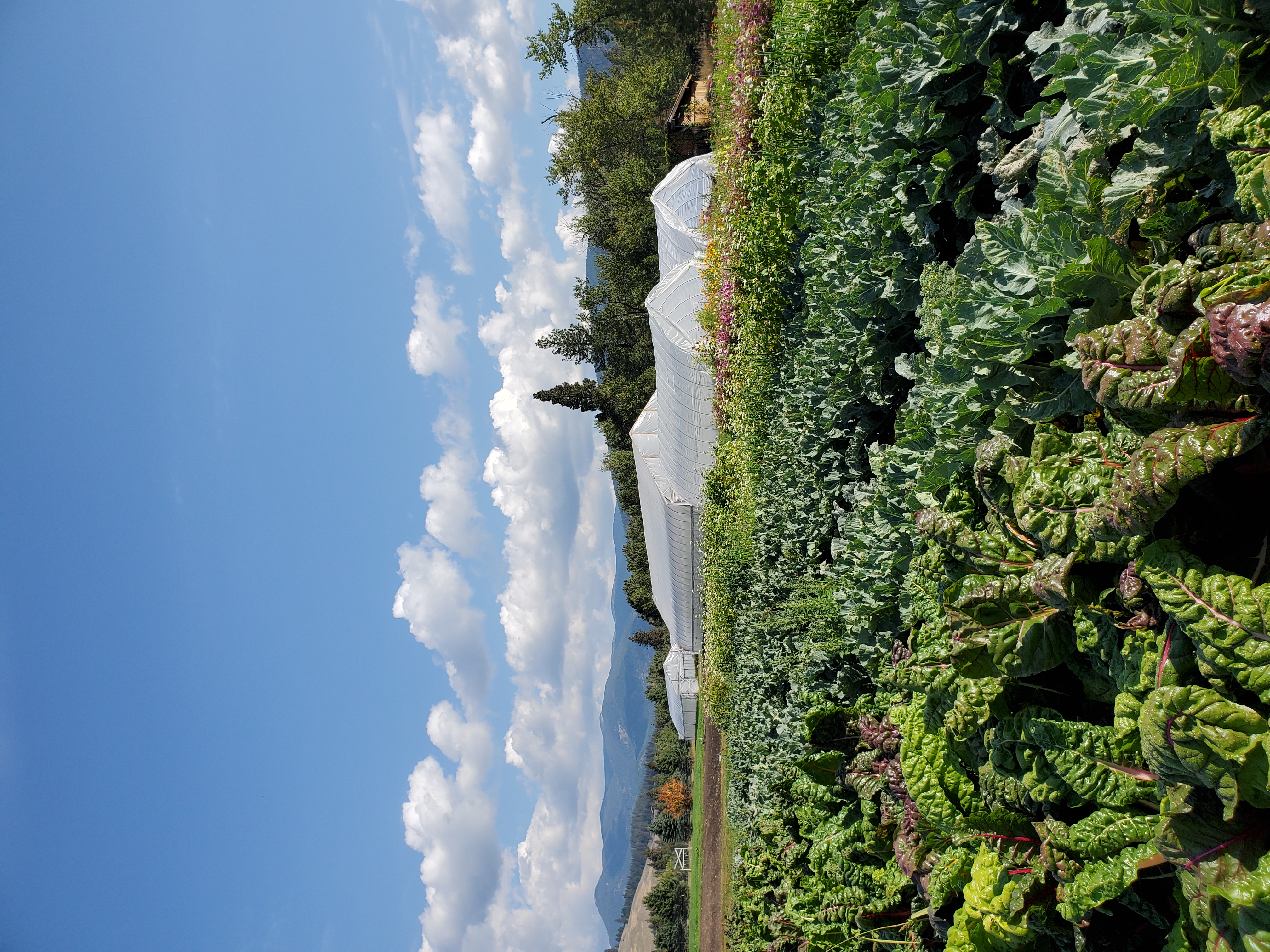Market Vegetable Farms: Soil Nitrogen & Sulfur
Department of Land Resources and Environmental Sciences Montana State University
Last Updated: 11/22by By Kathrin Olson-Rutz, Research Associate, and Clain Jones, Extension Soil Fertility Specialist and Professor
MARKET VEGETABLE FARMS:
Soil Nitrogen & Sulfur
This is one of three MSU Extension bulletins available to help mixed-vegetable farmers (market gardeners) manage soil fertility and health. This bulletin presents nitrogen (N) and sulfur (S) amendment options, including cover crops, and guidelines to help select the right amendment source, rate, timing, placement, and rotations. Market Vegetable Farms: Soil Phosphorus, Potassium, & Micronutrients presents the same type of information for the other plant nutrients. Market Vegetable Farms: Soil Characteristics & Testing presents soil properties that are important to soil fertility management and how soil tests quantify those properties.
Overview
Healthy soils with sufficient and balanced nutrients for plant growth are the basis for high-quality production. Managing soil fertility using plant- or animal-based materials is complex since availability of nutrients depends on biological cycles to break down materials into plant-available forms. By understanding soil characteristics and amendments (anything added to the soil), producers can select the best amendment for their goals and budgets.
We use the term “amendment” to include any material added to improve the soil nutrient content, pH, functions (e.g., suitability for cultivation and germination), or health (e.g., water absorption and storage, stability against erosion). In this bulletin, organic material refers to plant- or animal- based sources (e.g., plant residue or feather meal), not whether the material is allowed by national or state organic standards.
Even though many vegetable farm soils are high in soil organic matter (SOM), which provides inherent fertility to get a crop, they are often low in N. Sulfur (S) deficiency is not common, however, if S is deficient, then plant uptake of N and protein formation is limited and N-fixation by legumes (e.g., peas, beans, sainfoin) is reduced.
Bulky organic material such as manure and plant residue provide a variety of nutrients and improve soil condition as it affects nutrient cycling, water absorption and storage, stability against erosion, and suitability for cultivation and seed germination. However, whether composted or not, they can be too low in N to supply a vegetable crop’s N requirements, and other nutrients may not be in a correct balance. Use caution in trying to meet crop N needs with fresh or composted manure or compost high in food waste. These are much higher in phosphorus (P) and potassium (K) than plants require. Excess P and K can lead to P runoff and water contamination, and poor crop growth, production, and quality.
Amendments with high nutrient concentrations may be necessary to supplement N or S supplied by organic materials and SOM. They can be less expensive and labor intensive than using compost. The amount of N and S supplied by any amendment depends on the characteristics of the material applied and the soil environment. Variation in N concentrations and timing of N release make precise N addition challenging when using organic materials, including cover crops. Fertilizing with minerals or salts, such as ammonium sulfate, is more predictable because it relies less on microbial activity, but it does not supply a diversity of nutrients or the non-nutrient benefits of adding organic material.
Only a portion of the nutrients in an amendment will be available within the growing season of application. Fresh materials that break down (decompose) readily and are high in N (e.g., pea cover) supply more N, more quickly, than dry, low N-containing materials (e.g., corn stalks). Nitrogen supplied is closely tied to microbial decomposition, which is faster in warm, moist conditions. Chopping plant residue and tillage increase the rate of decomposition.
Materials that release nutrients quickly (e.g., feather or blood meal) can be applied shortly before peak plant growth, or in-season. Materials that release nutrients slowly (e.g., compost, elemental S) need to be applied months or seasons before needed by the crop, and they provide nutrients for several years.
Combining soil tests and observations of plant nutrient deficiency symptoms (see MSU Extension Soil Fertility Nutrient Deficiency and Toxicity) can help determine if nutrient deficiency is the cause of poor plant growth. Amendment N rates should be based on spring soil nitrate-N tests (see Market Vegetable Farms: Soil Characteristics & Testing) and adjusted for estimates of N that will become available during the growing season from decomposition. Unguided fertilization without knowing what is already in the soil can lead to under-fertilization and limited yield. Conversely, over-fertilization uses amendments, money and labor that are likely better used elsewhere, and potentially contaminates surface and groundwater.
Crop rotations, including covers, can be used to catch, hold, and recycle nutrients on-site, and supply N when they include legumes. Small annual or in-season additions of organic material benefit soil nutrients and health with less risk of environmental contamination than large additions every few years. By using the right source, at the correct rate, application timing, and placement, along with crop rotation, market gardeners can supply N and S, and maintain healthy soils to produce high-quality crops with the best use of limited resources. Each location and season is unique. Before applying a new nutrient management practice to a whole farm, use small-scale trials to help figure out what works in each situation.
Amendment Options
Small farm logistics, including budget, space, time, machinery, weather, and labor often dictate what material is added and how it is handled. In the big picture, consider the source of amendments, and the environmental and societal costs of their harvest, mining, production and transport. For example, Chilean nitrate is mined and transported from Chile, canola meal is a more regionally available source of N and S than sea kelp, and alfalfa meal could require large amounts of irrigation.
Soil organic matter is an important source of a variety of nutrients. It is useful for soil aggregation, water infiltration and drainage, low compaction, minimal crusting, nutrient holding capacity, and resistance to pH change. It comprises dead and decomposed plant and animal material and living and dead soil microbes (e.g., bacteria, fungi, nematodes). It can only be increased in soil by adding organic material, whether from outside sources or covers and crop residue. For more information on building SOM, see Market Vegetable Farms: Soil Characteristics & Testing.
Most manures (except poultry) are low in N, yet are excellent sources of several other nutrients and organic matter. Often manures are a waste or byproduct. Their use closes local or regional nutrient cycling loops. Barriers to using manure are transportation, odor, runoff or leaching risk to water quality, nutrient content variability, logistics, time, labor, and plant burn if manure is high in ammonia. Soils amended with fresh or composted manure to meet crop N or soil condition needs can quickly accumulate excess P and K. Manure can also be high in salt and can contain viable weed seed and herbicide residues, which are not eliminated by composting. Be sure to follow state and national regulations regarding use of manure in vegetable production.
Compost is material created by decomposition of organic material. Finished compost is crumbly and dark. Finished manure compost no longer smells of ammonia. Compost is better suited as a soil conditioner and source of P, K, and micronutrients than of N. Fresh manure and compost have low and variable concentrations of nutrients, so it is difficult to know at what rate nutrients are applied. They are high in bulk, so they require a lot of labor for low nutrient input.
Compost decomposes and releases N more slowly than fresh material, largely because readily available N was released during the composting process. It provides greater soil aeration and resistance to water and wind erosion than non-composted organic materials (1). Composting can reduce weed seeds and pathogens. Salts, heavy metals, and other contaminants (e.g., herbicide residue) can enter the compost through items such as processed food, paper, municipal plant waste, or manure and litter from commercial feed-lots (2). Active composting partially binds heavy metals and other contaminants to organic matter particles, making them less plant available (3). The soil benefits of adding material from passively managed plant debris piles are somewhere between fresh residue and finished compost.
Cover crops, also called green manure, are plants grown in time and/or space between the cash crops. They capture and recycle N and S that could be lost to leaching and can add N if they contain legumes. For covers to contribute, rather than tie up N, legumes should be terminated at budding, and cereals (grasses) around the end of tillering or beginning of jointing (stem elongation). If terminated later, they still add plant residue, extend the portion of the year that active roots are in the soil, protect the soil surface from rain impact and water and wind erosion, suppress weeds (or add weeds if left to go to seed), and increase soil microbial activity which can increase nutrient availability, all of which benefit soil health. Challenges of growing covers include time, labor, and allocating land. Areas of Montana are also faced with a narrow planting window between a mid- to late-season harvest and the onset of winter, irrigation often being turned off in early fall, and extreme weather that causes untimely kill. Covers require a long-term perspective on soil fertility because of the slow rate at which they improve soils.
Mulch is material left on top of the soil surface. If made of organic material it can add N and S (4, England) to the top few inches of soil, but its larger purpose is to protect soil from the impact of rain and soil erosion, reduce weeds, and hold in soil moisture. Mulch can come from various sources, including mowed cover, compost, bark, or straw. In contrast to incorporated organic material, mulch decomposes slower, adds nutrients more slowly and does more to protect the soil surface.
There are several specialty products available that generally come in a bag from off the farm. Those intended to supply a specific nutrient usually have a guaranteed nutrient content level, called grade. Grade labels specify percent by weight of total N, available P2O5 and soluble K2O, and sometimes S. For example, alfalfa pellets (2-0.5-2-0.2) contain about 2% N, 0.5% P2O5, 2% K2O, and 0.2% S of the weight of the fertilizer. Common off-farm specialty items include elemental S and blood meal or feather meal. Materials that are more complex (e.g., feather meal is more complex than elemental S), are more variable in nutrient content and less likely to have an exact grade.
Supplying N and S
Vegetables require around 2.4 lb plant-available N/1000 ft2 in the top foot of soil (105 lb N/acre) during peak plant uptake for healthy plant growth and yields (5, OR). Some vegetables require more N than others (Table 1). This N needs to come from soil nitrate and plant available N (PAN) released during the growing season from SOM and fertilizer, cover crops, or other amendments. Spring soil nitrate-N tests determine the amount of N available early in the growing season. Rules of thumb and ways to calculate estimates for growing season PAN are discussed in the Plant Available N section.
Table 1. Crops known to require more than average amounts of N (6, WI; 7, WA, OR).
| Beet | Corn | Onion |
| Brassica | Garlic | Pepper |
| Carrot | Lettuce | Potato |
| Celery | Melon | Tomato |
Sulfur requirements are less well defined. Soils with less than 5 ppm SO4-S may be S deficient. However, soil test level does not help calculate how much S is needed or whether yields will increase with the addition of S. Soil organic matter is a major source of S for plants. The S content and its release from SOM is highly variable and hard to predict. Considering field history and looking at plants for symptoms of S deficiency (yellow upper leaves) are tools to guide S amendment decisions (Market Vegetable Farms: Soil Characteristics & Testing).
Only a portion of the N and S taken up by plants is removed from the field at harvest. On average, vegetable harvest removes 2 lb N/1000 ft2 (Table 2). Nitrogen can also be lost through nitrate leaching and volatilization (loss to air as ammonia gas). When nitrate moves down in the soil below crop rooting depth it is both a loss of N from the system at a cost to the grower and risks groundwater contamination. Four key fertilization management options, along with using crop rotations, ensure the maximum amount of nutrient applied is used by the crop (fertilizer use efficiency; Table 3) and losses are minimized.
Table 2. Pounds of N removed by average vegetable harvest (8, MA; 9, OR; 10, Germany).
| Vegetable harvested | N removed (lb/1000 ft2)1. |
| Squash (Winter/Summer) | 0.5 |
| Broccoli | 1.0 |
| Cauliflower | 1.3 |
| Beet | 1.4 |
| Lettuce | 1.7 |
| Carrots | 1.8 |
| Corn | 1.8 |
| Potatoes | 2.2 |
| Onions | 2.3 |
| Tomato | 2.5 |
| Kale | 2.9 |
| Pepper | 3.1 |
| Average | 1.9 |
1. Multiply by 43.6 to get approximate removal per acre
If soil nutrients are sufficient and balanced, the cause of languishing plants could be disease or pests, nutrient uptake issues caused by root disease, cold soils, or poor irrigation. Adding more nutrients will not improve plant health.
The concepts presented here apply to fields and high tunnels. But decomposition is likely faster, and nutrient losses through leaching, runoff and erosion are likely smaller in high tunnels than on open fields.
Source
The amount of N and S supplied depends on the source’s N and S concentration and the rate nutrient is released to plant available form. In general, providing N with most manures or compost is inefficient as the concentration of N per pound of material is relatively low (Figure 1, Table 4). Composts and SOM provide season-long, slow, stable N that may need to be augmented with fresh, high-N, easily decomposed materials before and at planting to provide early to mid-season N. Liquids or other sources with high concentrations of nutrients that are released quickly (Table 5) are useful for in-season N application. The following explains nutrient content and rate of release from many amendments and cover crops to help growers select the most appropriate source to meet plant needs.
Table 3. Four key fertilization management options, along with using crop rotations, that ensure maximum amount of nutrient applied is taken up by the crop.
| Source | Select among sources that supply nutrients quickly (e.g., urea, compost tea, sulfate) for in-season fertilization, and slowly over time (compost, elemental S, slow-release urea such as ESN®). |
| Rate | Determine rates based on soil test and estimated crop demand. |
| Timing | Apply readily available sources shortly before crop growth spurt, or in small doses over the growing season, especially on coarse or shallow soils. Slow release requires months or years to become available. |
| Placement | Place mulch and elemental S on the soil surface; incorporate fresh plant residue/manure/urea/meals to minimize ammonia volatilization; band to reduce weeds; use foliar spray as rescue. |
| Rotation | Have a crop or cover crop in place to catch available N from a legume cash or cover crop; alternate crops that require high vs. low amounts of nutrients; plant leafy crops rather than root crops after high N input; rotate low N residue with high N residue crops and amendments. |
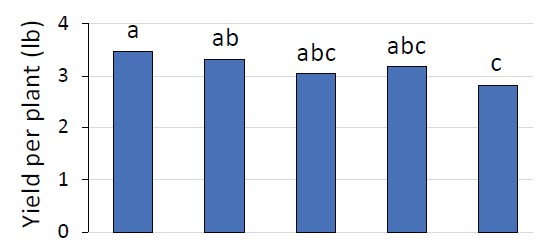
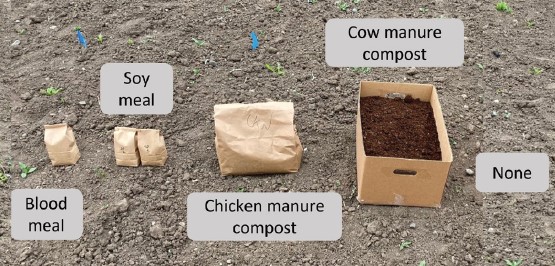
Figure 1. The amount of material necessary to apply 3 lb N/1000 ft2 (131 lb N/acre) on a 50 ft2 bed, and average total annual yield of tomato and cucumber per plant with each amendment. Bars with at least one letter in common are the same with 95% confidence. Image and data by 11.
Table 4. The approximate range in the amount of N supplied in the forst growing season by a given volume of amdenments, and volume needed to supply 2.4 lb N/1000ft2 for an average vegtable harvest.
| Amendments | lb N/ton | % N Avaliable in first season | lb for 2.4 lb N | # ton for 2.4 lb N | # yrd3 for 2.4 lb N | #5-gallon buckets for 2.4 lb N | # Quarts for 2.4 lb N | # inches for 2.4 lb N/1000ft2 | lb N/1-inch on 1000 ft2 |
| Dairy solids (as-is) horse manure (w/bedding, as-is) | 6 to 10 | -51. to 10 | 4800 to not possible2. | 2.4 to NP | 3.2 to NP | 136 to NP | 2720 to NP | 1.2 to NP |
-1 to 2 |
| Coffe grounds (dry) | 2 | 0 to 10 | 24000 to NP | 12 to NP | 26 to NP | 1066 to NP | 2132B to NP | 8.8 to NP |
0 to 0.27 |
| Horse manure (no bedding, as-is) dairy solids/beef manure compost | 8 to 18 | -6 to 15 | 4000 to NP | 1.4 to NP | 2.8 NP | 114 to NP | 2288 to NP | 1.0 to NP | -1 to 2.5 |
| Alpaca, llama, sheep, goat, rabbit (all as-is or compost), beef (as-is), manure | 14 to 20 | 15 to 40 | 600 to 2240 | 0.3 to 1.1 | 0.5 to 1.7 | 20 to 66 | 400 to 1213 | 0.2 to 0.6 | 6 to 14.3 |
| Yard compost | 18 | 0 to 20 | 1280 to NP | 0.6 to NP | 1.4 to NP | 59 to NP | 1184 to NP | 0.5 to NP |
0 to 4.9 |
| Alfalfa pellets/meal, vermicompost ( cating + residue) | 36 to 38 | 18 to 25 | 528 to 706 | 0.2 to 0.3 | 1.0 | 38 to 39 | 768 to 784 | 0.3 | 7.3 to 7.4 |
| Poultry Manure w/ or w/out litter (dry/compost/pellets) | 44 to 78 | 30 to 60 | 122 to 363 | 0.08 0.4 | 0.08 to 0.4 | 3.2 to 16 | 64 to 320 | 0.03 to 0.13 |
18 to 84 |
| Bone Meal | 46 | 30 | 348 | 0.16 | 0.16 | 8 | 154 | 0.06 | 37 |
| Canola Meal | 104 | 40 to 60 | 77 to 1150 | 0.04 to 0.05 | 0.08 to 0.11 | 3.0 to 4.6 | 62 to 92 | 0.02 to 0.04 | 62 to 93 |
| Soybean Meal | 126 | 60 | 63 | 0.03 | 0.05 | 1.7 | 34 | 0.016 | 170 |
| Feather Meal | 237 | 75 to 100 | 20 to 27 | 0.008 to 0.016 | 0.01 to 0.02 | 0.7 to 0.9 | 14 to 18 | 0.008 | 316 to 421 |
| Blood Meal | 230 | 75 to 100 | 21 to 28 | 0.008 to 0.016 | 0.01 to 0.02 | 0.6 to 0.8 | 12 to 17 | 0.008 | 349 to 465 |
| Fish Meal | 190 | 75 to 100 | 34 to 36 | 0.008 to 0.016 | 0.02 to 0.03 | 1.0 to 1.4 | 20 to 27 | 0.008 | 213 to 285 |
| Fish emulsion | 2 to 5% | 100 | 5.2 to 13.2 5-gallon Buckets Concentrate | ||||||
| Urea | 920 | 100 | 5.2 | 0.0024 | 0.003 | 0.16 | 2.6 | 0.0008 | 2236 |
| Covers: see Table 10 | |||||||||
Table 5. Nutrient sources that provide plant available N and S at rapid, moderate, and slow rate.
| Nutrient | Rapid | Moderate | Slow |
| N |
Manure/compost tea Fish emulsion
Blood meal
Poultry manure, dairy/pig manure slurry
Urea
Chilean nitrate
Ammonium sulfate
|
Fresh plant residue
Mammal manure solids
Poultry litter with manure Feather/alfalfa/canola meal
Slow-release chemical fertilizers (e.g., ESN®)
|
Compost |
| S |
Ammonium sulfate Gypsum
Epsom salt
Blood meal
|
Feather/canola meal | Elemental S |
Table 6. The N content (%) of common amendments either stockpiled (as-is) or composted. The meals and pellets are in the format they come in the bag.
| Manures1. | N (%) | Plant products1. | N (%) |
| Alpaca/llama | 0.8 | Alfalfa meal | 2.0 |
| Beef cattle | 0.4 | Canola meal | 5.8 |
| Beef cattle compost | 0.8 | Soybean meal3. | 7.3 |
| Dairy solids (separated) | 0.1 | Leaves dry4. | 1.0 |
| Dairy solids (separated) compost | 0.1 | Yard debris compost | 0.3 |
| Goat/sheep | 0.8 | Grass clippings fresh5. | 3.6 |
| Horse no bedding | 0.4 | Coffee grounds dry matter basis | 2.0 |
| Horse w/bedding | 0.5 | Vermicompost6. | 2.6 |
| Rabbit | 0.9 | Sugar beet pulp as is (animal feed) | 1.6 |
| Rabbit compost | 0.9 | ||
| Other animal products1. | Chemical | ||
| Poultry manure pellets | 4.0 | Urea | 46 |
| Poultry manure w/litter | 3.1 | Mono-ammonium phosphate | 11 |
| Poultry manure w/litter compost | 2.9 | Liquid ammonium phosphate | 10 |
| Feather meal | 12 | ||
| Blood meal2. | 13.5 | ||
| Bone meal2. | 3.3 | ||
| Fish meal | 10 | ||
| Fish emulsion | 4.2 |
2. 7
3. 12. Soybean meal should be broadcast and incorporated at least 2 weeks before seeding/transplanting to avoid inhibition of germination and growth.
4. 14
5. 15
6. 16
Nutrient Content
Table 6 lists the N content of common amendments. Ideally, one N source would provide N as needed
by the crop during the growing season. Soil organic matter provides too little N, and organic
materials such as compost contain low and highly variable concentrations of N. Therefore, a
combination of N sources, such as compost and feather meal, may be needed to meet crop needs.
Table 7 lists some S sources. In addition to S, gypsum also adds calcium (22% Ca), which improves
soil aggregation in high sodium soils. Epsom salt adds magnesium which can interfere with calcium
uptake in soils with sufficient magnesium. Elemental S can acidify soil. Knowing whether soil is
high in sodium, low in magnesium, or already acidic is important to select the correct amendment.
Possible by product S sources include f eather meal, blood meal, and canola meal (Table 7).
With chemical fertilizers, grade label values usually equal the amount of N and S that are readily plant available. Organic materials may come with a grade, or they can be tested for nutrient content. However, with organic materials or minerals such as elemental S, the amount of N and S available in the first growing season can be just a small fraction of the total N and S amount in the amendment. Even when 3 lb N/1000 ft2 total N was added, yields were compromised with composts because only a portion of the N became plant available (Figure 1).
RATE OF RELEASE
Table 5 lists nutrient sources by the rate nutrients become plant available. The nutrient release
rate depends on the source’s characteristics and the soil environment.
Nitrogen release is most rapid under similar conditions to those ideal for plant growth. There is little decomposition below 50°F, whereas 70–95°F is ideal. Soil needs to be moist, optimally at 35% water content (50-60% water-filled pore space; 21), and not compacted.
Table 7. Approximate concentration of S in amendments.
| Amendment | S (%) |
| Greensand1. | 0.3 |
| Epsom salt | 12.9 |
| Gypsum | 17.0 |
| Sheep manure compost2. | 0.3 |
| Kelp1. | 2.9 |
| Feathermeal1. | 1.7 |
| Blood meal1. | 0.5 |
| Bone meal1. | 0.1 |
| Soybean meal1.,4. | 0.3 |
| Canola meal3. | 0.8 |
| Fish meal1. | 0.8 |
| Alfalfa pellets5. | 0.2 |
Because soil biological activity is slow until soils become warm, and conditions need to be suitable for about four weeks before significant decomposition occurs, organic material or cover residue might not supply sufficient N for growth in March through May. Fall or early spring planted crops could require N fertilization at planting or in early spring due to this lag in available N.
Thick layers of organic material on the soil surface keep soil cool and slow decomposition. In contrast, tarps or high tunnels produce higher soil temperatures and moderate soil moisture for earlier and quicker decomposition, and reduced N losses to leaching or N gas loss in water saturated soils (denitrification). Fields with three, six, and 10 weeks of tarping prior to seeding had four, five, and nine times the plant available N (PAN) as un-tarped fields, respectively (22, NY). Weed biomass was not affected by the length of time tarps were in place.
Decomposition and plant uptake are high and well matched in early summer. Material that decomposes moderately to slowly should not be applied mid-growing season because it will release PAN into mid-to-late summer if temperatures are warm and there is moisture. As crops mature mid-to late- summer, plant N uptake declines, leaving PAN released at that time vulnerable to loss.
If soil moisture and temperature are suitable for microbial activity, rate of decomposition and nutrient availability are mostly affected by organic material freshness and the amount of structural material (e.g., lignin, cellulose and hemicellulose) it contains (23). Raw, fresh materials (covers, fresh manure) with high leaf vs. stem material, and concentrated materials (blood, feather, fish, seed meals) decompose quickly (24). After the initial rapid decomposition, the remaining material decomposes slowly; it becomes compost in the soil. Organic material high in structural matter (e.g., straw, wood shavings) breaks down slowly. Some secondary plant chemicals (e.g., tannins, resins in bark or cedar wood products, wax on leaves such as oak) also reduce decomposition rate (25).
The carbon to nitrogen ratio (C:N) of the material, by itself, is not always a good indicator of decomposition rate. Fresh and composted broiler litter have similar C:N (10:1 and 9:1), as do fresh and composted dairy solids (20:1 and 19:1), but the fresh form decomposes more quickly (Figure 2). Composted broiler litter (C:N 9:1) and fresh dairy solids (C:N 20:1) decompose at a similar rate. When comparing fresh material, such as plant residue, material with low C:N (high N concentration) decomposes more quickly than material with high C:N (low N concentration).
Chemical fertilizer nutrient availability is also affected by the environment. Urea converts quickly to ammonium and then to nitrate under warm, moist conditions. Specialized fertilizer products designed for slow release (e.g., ESN®) also release nutrients more quickly under warm, moist conditions.
Sulfur amendments have variable rates of S release (Table 5). Elemental S breaks down more quickly
if exposed on or near the soil surface to wet-dry and freeze-thaw cycles (26).
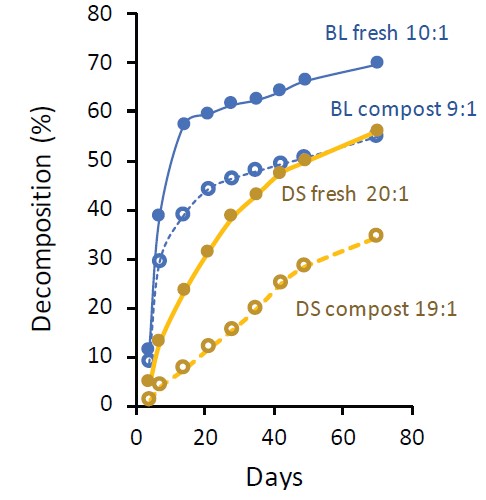
Figure 2. Fresh broiler litter (BL) and dairy solids (DS) decompose faster than the same materials composted. C:N provided for each material (24, lab).
|
KEY POINTS on N content and rate of release
|
Plant Avaliable N
Nitrogen concentration (from grade label, published values, or lab analysis) can be used to predict PAN for the growing season the amendment is added (Figure 3; PAN Calculation box). Oregon State University’s online calculator (https://smallfarms.oregonstate.edu/calculator) estimates growing season PAN based on the type of amendment, percent dry matter, N content in dry matter, and application rate. Table 4 has ranges of published values for N content, PAN in the first season, and calculations of how much amendment is needed to supply a given amount of N in the first season.
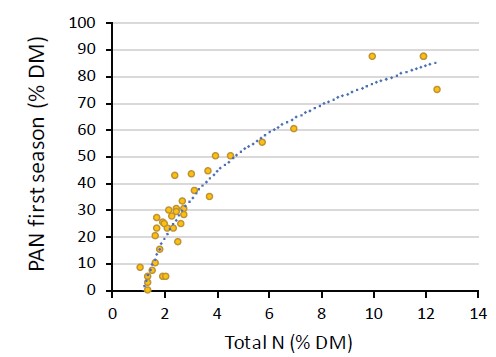
Figure 3. Plant available N in the first season increases with total N concentration in the amendment added. Both PAN and total N are on a % dry matter basis (% DM; 7, 13, 27).
The C:N ratio is useful for understanding whether an organic material will provide PAN or tie up N. During decomposition, microbes use C sources (e.g., sugars, cellulose) as their energy and N for growth from either the organic material they are working on, or the soil if necessary. When organic material C:N is less than around 20, decomposition supplies N (Table 8). At C:N greater than


